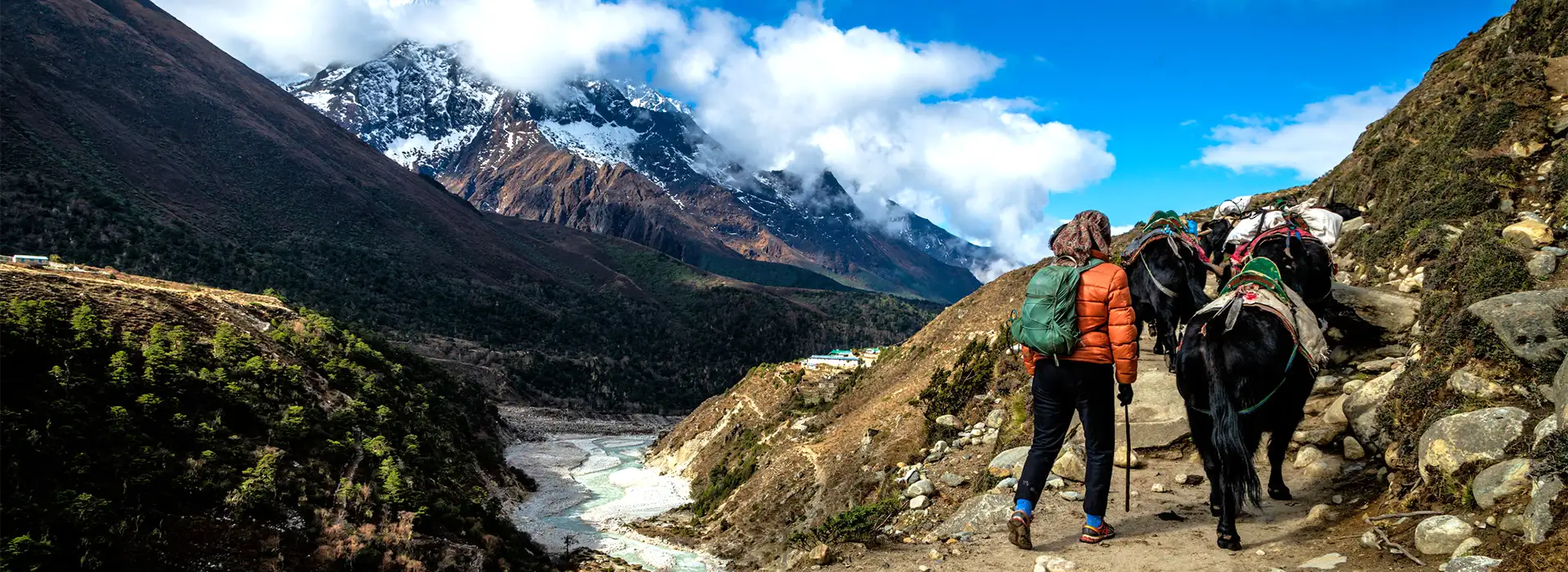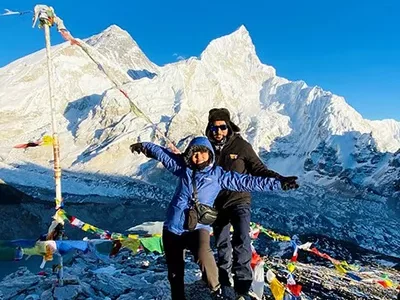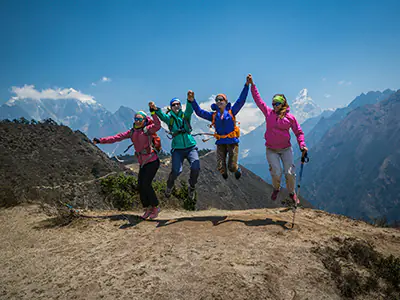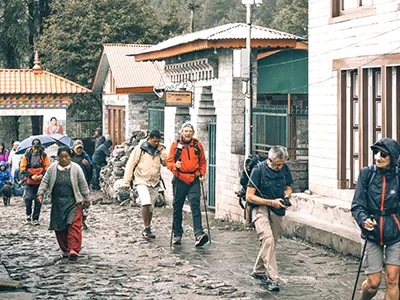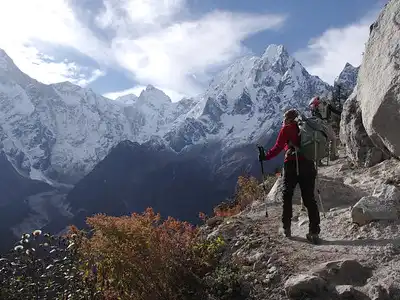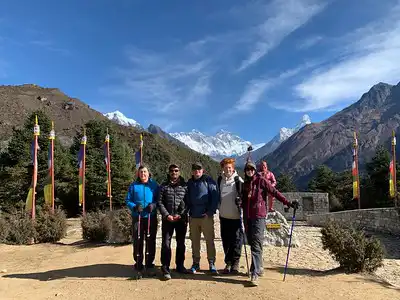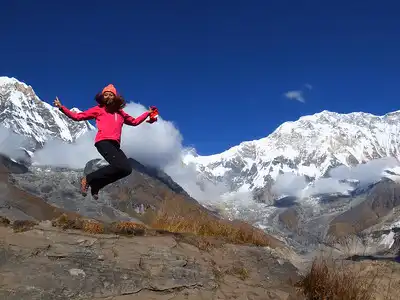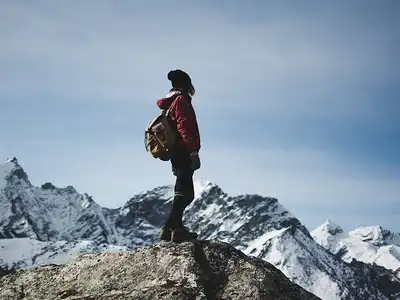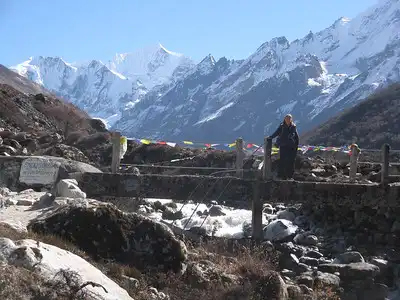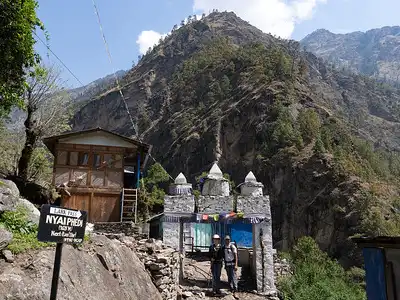Trekkers worldwide view the Everest Base Camp Trek as the ultimate adventure, offering a journey unmatched in its proximity to Earth’s highest peak. Its fame reaches across continents, drawing a varied group of adventurers keen to experience this famed path. The trek tests both the physical and mental strength of its participants, plunging them into the Himalayas’ rich cultural fabric, making Everest Base Camp not only a popular term in trekking tales but also in stories of personal growth and resilience.
Trekking to the Everest Base Camp height unveils an unrivaled adventure where trekkers face the mountains’ stark beauty and the challenges of thinner air. Planning for the Everest Base Camp Trek, which includes the costs of permits, guides, porters, and accommodations, becomes crucial to ensuring a safe and rewarding journey. Moreover, this trek allows for the capture of Everest base camp photos, showcasing the grandeur of the peaks and the trail’s dynamic atmosphere.
Preparation for the trek necessitates an understanding of the Everest base camp temperature, which varies from mildly cool to extremely cold, affecting both what trekkers pack and their readiness for the journey. This blog aims to guide readers through these elements, shedding light on why the Everest Base Camp Trek is essential for adventure seekers and how the Everest Base Camp symbolizes an adventure that continues to inspire explorers globally.
Everest Base Camp Trek
Everest Base Camp Trek for Beginners
Luxury Everest Base Camp Trek
Check out the 8 reasons to go on Everest Base Camp Trek
1. Scenic Flight to Lukla Airport
Flying to Lukla Airport, known as one of the most exciting short flights in the world, kick-starts the unforgettable adventure to Everest Base Camp. This flight challenges travelers and provides a magnificent aerial view of the Himalayas. The plane weaves through narrow valleys flanked by towering peaks, offering passengers stunning views that define the Lukla Airport experience. As the plane nears the famously short runway, the excitement peaks, making the landing an adrenaline-inducing part of the trekker’s journey.
Many consider taking Lukla airport photos essential, capturing the thrill and beauty of the adventure’s start. However, Lukla weather significantly influences the airport’s operations, often causing abrupt flight adjustments and bringing a sense of unpredictability. Known as Tenzing-Hillary Airport, it has witnessed several Lukla airport crash incidents, underscoring the dangers of its tricky location and high Lukla altitude. Nevertheless, it stands as a crucial gateway to the trek, leaving a lasting impression on those who begin their Everest Base Camp journey.

2. Culture and Lifestyle of the Sherpa People
The Sherpa community, integral to Himalayan trekking, showcases its Sherpa culture through enduring traditions and mountaineering skills deeply rooted in the region’s challenging environment. These indigenous people, known for their extraordinary climbing abilities, cherish a spiritual bond with the sacred mountains. Trekkers in the Everest region immerse themselves in Sherpa life, celebrating vibrant festivals and experiencing unparalleled hospitality, which deeply enriches their journey.
Firsthand experiences of Sherpa hospitality symbolized through the warmth of a Sherpa blanket or the comfort found in wearing a Sherpa jacket, allow trekkers to connect with the community’s cultural heartbeat. The Sherpa auto transport provides essential logistical support, showcasing how the community has embraced tourism while preserving its heritage. Wearing Sherpa fleece offers comfort against the cold, embodying the practical and cultural adaptability of the Sherpas. Legendary figures like Tenzing Norgay Trainor and Kami Rita Sherpa, with their extraordinary mountaineering feats, personify the Sherpa’s indomitable spirit and expertise, bringing depth to trekkers’ appreciation of this enduring and hospitable culture.
3. Teahouses Along the Trail
Teahouses nestled in the Himalayas are a charming feature of the Everest Base Camp trek, serving as welcoming havens where hikers can rest and dine. These quaint accommodations offer trekkers a unique opportunity to immerse themselves in the Sherpa community’s gracious hospitality and culture during their journey.
In comparison to other trekking routes in Nepal, like Annapurna Base Camp, Manaslu Trek, and Langtang Trek, the Everest region’s teahouses stand out for their quality. They offer a variety of meals, including hearty soups (such as vegetable and noodle soup), traditional Nepali dishes (Dal, Bhat, pickle, vegetables, and meat), noodles, bread, eggs, fruits, and local delicacies like Shyakpa, Thukpa, Rildok, and Tsampa.
The genuine hospitality of the Sherpa families, with their friendly smiles, makes trekkers from across the globe feel welcomed into a tight-knit community. These teahouses, though modest, provide the necessary comfort and convenience for trekkers after an exhilarating day of exploration. With delicious food and snug accommodations, they allow trekkers to rejuvenate for the upcoming challenges.
Residing in these unassuming lodges amid the stunning vistas of the Himalayas enriches the trekking experience, allowing adventurers to engage with the spirit of exploration fully. The satisfying meals and comfortable stay on the Everest Base Camp trek contribute to making the journey a memorable adventure.
4. Sagarmatha National Park
Sagarmatha National Park, a central highlight of the Everest Base Camp trek, holds a place on the UNESCO World Heritage Site list. Its breathtaking landscapes of snowy Himalayan peaks, verdant forests, and scenic rivers captivate visitors from around the world.
Winding through Sagarmatha National Park, the trails to Everest Base Camp lead to the home of Mount Everest, the world’s tallest mountain. This park boasts a rich tapestry of biodiversity, featuring an array of flora and fauna, including the blooming rhododendrons and the elusive snow leopards.
Diverse plant and animal life thrive in Sagarmatha National Park. In spring, rhododendrons, Nepal’s national flower, burst into a spectrum of colors, enhancing the park’s beauty. Additionally, trekkers can admire various other flowers like primroses, blue poppies, and edelweiss, which become prime attractions during the trekking seasons.
Bird-watchers will delight in spotting species like the Himalayan Monal, also known as Danphe, Nepal’s national bird, known for its colorful and iridescent plumage. The Blood Pheasant, Golden Eagle, and Lammergeier also grace the skies of the park, offering spectacular sightings.
Inhabitants of the park include the Himalayan Tahr, the rare Snow Leopard, the endangered Red Panda, Musk Deer, Himalayan Black Bear, and Himalayan Marmots, adding to the trek’s wild allure.
Sagarmatha National Park significantly elevates the Everest Base Camp trek experience, immersing trekkers in the stunning natural beauty and rich biodiversity of the Himalayas.

5. Mesmerizing Views of Towering Peaks
The Everest Base Camp trek unfurls a visual banquet, showcasing the world’s most iconic peaks in all their breathtaking grandeur. As trekkers traverse the rugged landscape, the majestic presence of Mount Everest, the Earth’s tallest peak, captivates the eye, flanked by its towering neighbors, Lhotse and Nuptse. This trio forms a spectacular panorama, showcasing the raw, unfiltered beauty of the natural world. Witnessing these colossal mountains, particularly the towering Everest, instills a deep sense of accomplishment and awe, enhancing the value of each step on this journey.
Further enriching this mountain spectacle, Ama Dablam stands out with its striking, Matterhorn-like silhouette, earning it the nickname “Matterhorn of the Himalayas.” Thamserku and Cho Oyu contribute their unique charms to this Himalayan gallery, each peak adding a touch of splendor to the trekker’s view. Taboche rises prominently, rounding off a scene that borders on the surreal. With their towering heights and distinctive forms, these mountains weave a mesmerizing tapestry that lingers in the memory of trekkers, embodying the peerless beauty of the Himalayas.
6. Trekking to Kala Patthar
Kala Patthar serves as the premier viewpoint for beholding Mount Everest, granting trekkers an unparalleled grand view. The journey to Kala Patthar challenges and rewards in equal measure, with its rugged paths leading to an extraordinary adventure. Renowned for its sweeping panoramas, this spot permits an intimate view of Everest’s immense scale. At an altitude of around 5,644 meters (18,519 feet), Kala Patthar offers a crisp, unobstructed sightline to Everest’s summit, justifying the strenuous trek to reach this pinnacle.
The Panoramic Splendor of Kala Patthar
Timing a visit to Kala Patthar for sunrise or sunset can create a spellbinding moment, as the shifting light casts the Himalayan giants in spectacular shades of gold, pink, and fiery orange. Despite the often chilly kala Patthar temperature during these hours, the view of the sun rising or setting against Everest provides a breathtaking scene, touted as a trek’s highlight by many. Kala Patthar’s vantage point delivers not just Everest in full glory but also a stunning wide-angle view of the neighboring peaks, making it an unmatched spot for capturing the beauty of the Himalayas.
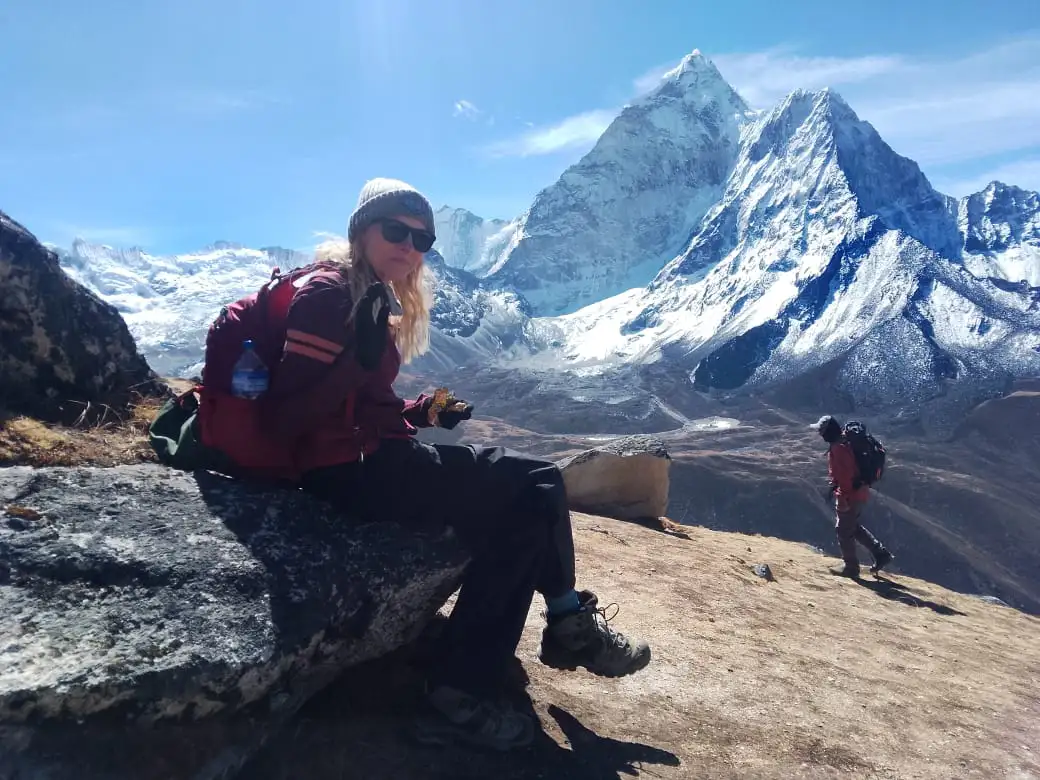
7. Mystical Himalayan Monasteries
On your trek to Everest Base Camp, you will come across various monasteries. Among these are Tengboche, Pangboche, Khumjung, Thame, and Debuche.
Tengboche Monastery: A Spiritual Nexus
Tengboche Monastery, positioned with an impressive backdrop of the Himalayan peaks, stands as a spiritual beacon in the Khumbu region. This monastery is famous for its beautiful murals and its panoramic view of Everest, drawing trekkers and climbers who seek blessings for their expeditions. Architecturally, Tengboche combines traditional Sherpa design with Tibetan influences, creating a space that is as spiritually significant as it is aesthetically pleasing. It serves as a pivotal place for religious festivals, most notably the Mani Rimdu festival, where rituals and dances connect the community and visitors in a profound cultural exchange.
Pangboche Monastery: An Ancient Sanctuary
Pangboche Monastery holds the distinction of being one of the oldest in the region, steeped in legend and history. It is renowned for its ancient artifacts and the mystical allure of Yeti folklore, claiming to have relics of this elusive creature. The monastery’s architecture, characterized by its rustic stone walls and traditional design, embodies the essence of Himalayan monastic life, offering a peaceful retreat from the bustling trek routes. Its quiet courtyards and prayer rooms provide a serene setting for contemplation and spiritual exploration.
Khumjung Monastery: Harmonizing Culture and Nature
Khumjung Monastery, nestled in the serene Khumjung village, is famous for housing a unique relic believed to be a Yeti scalp. This feature, along with its scenic location surrounded by green hills and clear mountain views, makes it a fascinating stop for cultural enthusiasts. The monastery itself reflects the Sherpa community’s deep-rooted spirituality and connection to the natural world, providing a harmonious blend of cultural heritage and natural beauty. Visitors to Khumjung can experience a quiet moment of reverence and enjoy a closer look at local religious practices and traditions.
Thame Monastery: A Remote Retreat
Thame Monastery, set in the Khumbu region’s remote area, provides a tranquil escape for those in search of solitude and spiritual renewal. Far from the main trekking paths, it allows visitors to experience monastic life in a less touristy setting. Known for its spiritual vitality and the practice of ancient Buddhist rituals, Thame Monastery invites trekkers to immerse themselves in a serene and contemplative environment. The journey to Thame itself is a meditative experience, offering stunning landscapes and a sense of peace that complements the spiritual ambiance of the monastery.
8. Reaching Everest Base Camp
The highlight of the journey, the Everest Base Camp hike, captivates both dreamers and seasoned mountaineers with the stunning allure of Mount Everest, the world’s tallest peak.
As adventurers embark on their trek, they encounter spectacular views of the snow-capped Himalayas, Sherpa valleys, ancient monasteries, vibrant landscapes, and icy glaciers. The journey’s thrill, coupled with the homely comfort of teahouses, renders the trek both memorable and exhilarating.
Reaching the base of the Himalayas, trekkers experience a profound mix of triumph, awe, and humility. Standing at the foot of the tallest mountain in the world, they find themselves amidst an overpowering and emotional scene, creating lifelong treasured memories.
With every step toward Everest Base Camp, the trek becomes an unforgettable tapestry of adventure, cultural engagement, and stunning natural splendor.
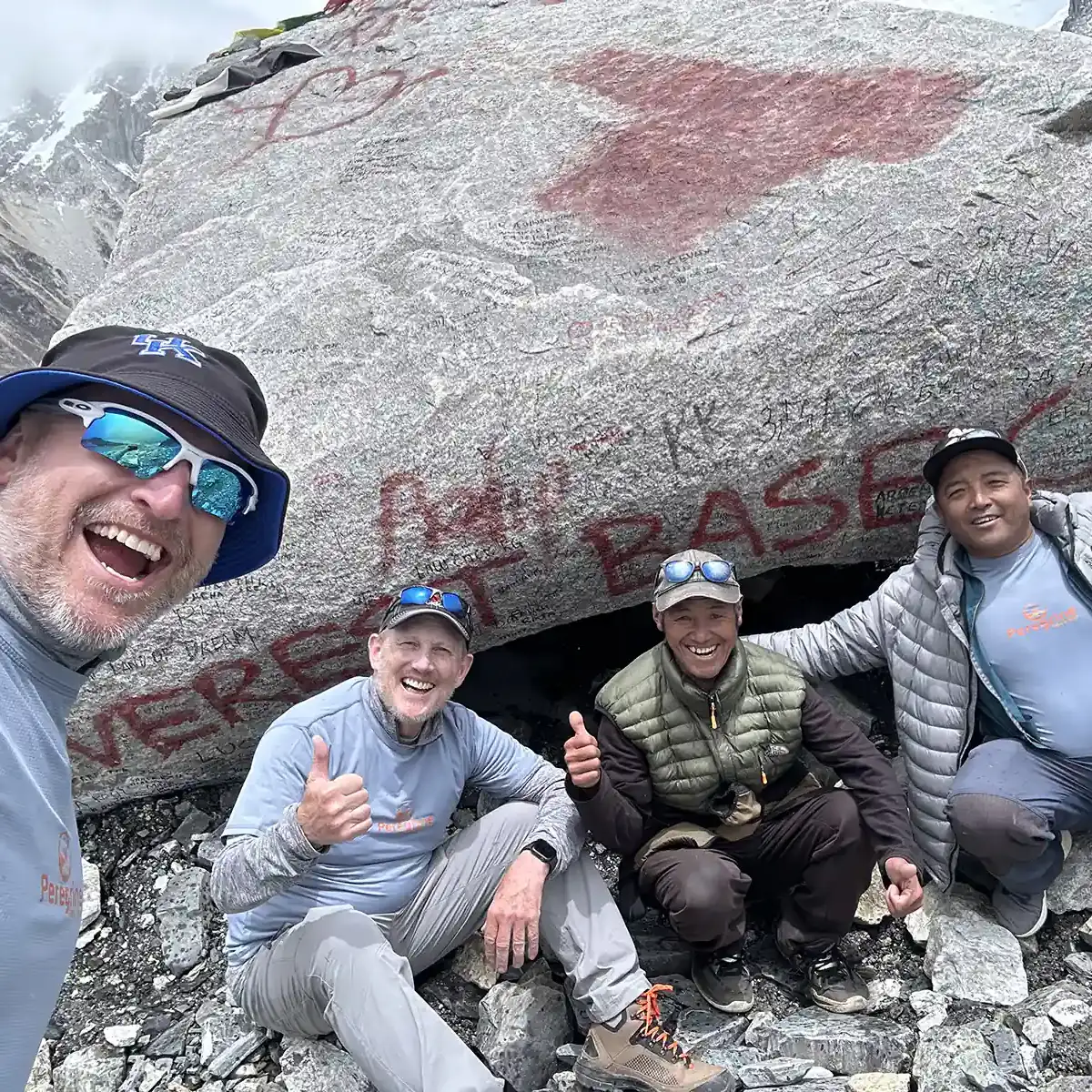
Conclusion: The Journey of a Lifetime
The Everest Base Camp Trek takes you on an unforgettable adventure that etches itself deeply into the heart and soul of every traveler. More than a mere physical endeavor, this trek transforms, combining the awe-inspiring beauty of the world’s highest summits with the rich cultural heritage of the Sherpa people. Trekking through diverse landscapes, from verdant valleys to stark terrains, and visiting ancient monasteries, trekkers cultivate a profound respect for nature and gain insight into the resilience and spirituality of the inhabitants.
The unparalleled sense of achievement one feels upon reaching Everest’s base camp fills the heart with a deep sense of accomplishment and humility. This trek, a confluence of natural splendor, cultural richness, and personal challenge, acts as a potent catalyst for growth and introspection. I urge everyone to view the Everest Base Camp Trek not merely as a destination but as a voyage into the essence of natural beauty, cultural richness, and self-discovery.
